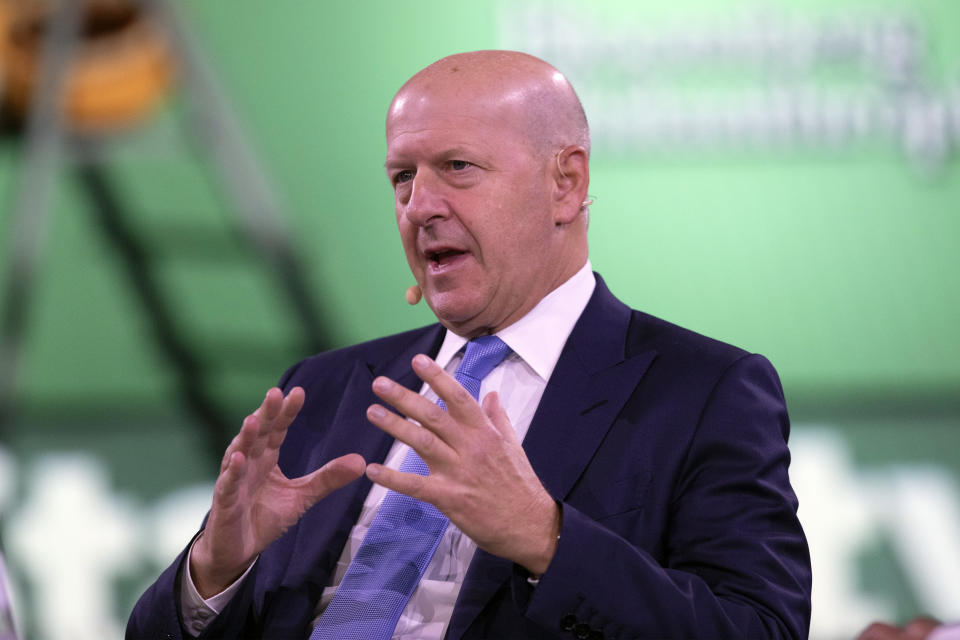Goldman Sachs Q4 profit falls, but sees higher bond trading, deal-making
Investment banking giant Goldman Sachs (GS) posted mixed earnings results on Wednesday, as the firm’s deal-making and bond trading weren’t enough to offset a drop in investment banking revenue.
Goldman’s stock, traded on the New York Stock Exchange, fell 0.6% from Tuesday’s trading, but added more than 30% in 2019.
Here were the key figures versus the expectations, according to analysts polled by Bloomberg.
Revenue (adjusted): $9.96 billion vs $8.56 billion expected.
Earnings per share (adjusted): $4.69 vs $5.52 per share expected

During 2019, litigation hit Goldman’s profitability, with the bank’s net legal provisions hitting $1.24 billion. During a call with analyst, CEO David Solomon said that a preponderance of that was related to the 1MDB scandal. He added that the firm is in “ongoing discussions relating to a potential settlement with relative authorities across multiple jurisdictions,” most notably the U.S. and Malaysia. He said that the conversations with authorities are “progressing” and they are “working hard” to bring closure to the matter. He also added that the incident is “not reflective” of the firm’s values, and they’re taking measures to improve.
The $9.96 billion revenue for the fourth quarter was 23% higher than the same period a year ago and 20% higher than the third quarter of 2019, driven largely by “significantly higher net revenues in Asset Management and Global Markets.”
Yet Goldman’s earnings per share in the fourth quarter fell short of Wall Street’s estimates, and were lower than the $6.04 posted in the comparable year-ago quarter, and $4.79 in the third quarter of 2019.
During the fourth quarter, Goldman saw a rebound in its trading businesses from the same period a year ago. Revenues for global markets came in at $3.48 billion, up 33% from the fourth quarter of 2018, but 2% lower than the third quarter of 2019.
Revenues from FICC trading rebounded 63% to come in at $1.77 billion, “primarily due to significantly higher net revenues in FICC intermediation, reflecting higher net revenues across most major businesses, including significant increases in interest rate products, commodities and mortgages.”
For equities, revenues jumped 12% from the same period a year ago to $1.71 billion, “reflecting improved spreads and higher average customer balances, and in Equities intermediation, reflecting significantly higher net revenues in cash products.”
Investment banking revenues during the quarter slipped 6% from the same quarter a year ago to post revenues of $2.06 billion, which was also 12% lower than the third quarter of 2019. Part of the reason for the dip in revenues was due to “significantly lower net revenues in Financial advisory and lower net revenues in Corporate lending.”
Part of the reason is there was a “significant decrease in industry-wide completed mergers and acquisitions volumes.” However, this was “partially offset” by “significantly higher” revenues in underwriting, which were driven by debt underwriting, asset-back activity, and equity underwriting.
Elsewhere, consumer banking revenues grew 23% to $228 million in the quarter, driven by “higher net interest income, primarily reflecting an increase in deposit balances.” For the year, the consumer banking business grew 41% to $864 million in net revenues.
On a call with analysts, CFO Stephen Scherr said the consumer business is “still in the early stages of growth.” He also noted that the bank has done around $2 billion in credit-card lending since the debut of the Apple Card.
Overall, Solomon applauded the “strong performance” for the fourth quarter that led to a “solid year.” He added that the firm will continue to invest in new businesses.
Goldman is the fourth major U.S. bank to report earnings this week. JPMorgan Chase (JPM), the largest U.S. bank by assets, kicked off earnings season with fourth-quarter results that beat Wall Street estimates in a record year. Citigroup (C) also beat estimates, but Wells Fargo suffered a 55% slump in profit as it struggled to put a litany of troubles behind it.
With the exception of Wells Fargo, analysts estimate that stable interest rates, loan growth — and healthy and free-spending consumers — will bolster banks’ bottom lines this year.
The U.S. economy’s health is a “key driver to bank performance in 2020, in our view, and we prefer large banks with an overwhelming weighting to the U.S. consumer and small business activity,” wrote Kenneth Leon, CFRA Research’s director of equity research, recently.
Javier David is an editor for Yahoo Finance. Follow Javier on Twitter: @TeflonGeek
Julia La Roche is a Correspondent at Yahoo Finance. Follow her on Twitter.
Read the latest financial and business news from Yahoo Finance
Follow Yahoo Finance on Twitter, Facebook, Instagram, Flipboard, SmartNews, LinkedIn, YouTube, and reddit.